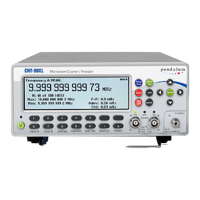starting at the trigger event. Charging is stopped at the leading edge of the first following clock pulse. The stored charge
in the integrating capacitor represents the time difference between the start trigger event and the leading edge of the
first following clock pulse. A similar charge integration is made for the stop trigger event.
When the “digital” part of the measurement is ready, the stored charges in the capacitors are measured by means of
Analog/Digital Converters.
The counter’s microprocessor calculates the result after completing all measurements, i.e. the digital time measurement
and the analog interpolation measurements.
The result is that the basic “digital resolution” of + 1 clock pulse (10 ns) is reduced to 100 ps for the CNT-90 and 50 ps
for the CNT-91(R).
Since the measurement is synchronized with the input signal, the resolution for frequency measurements is very high
and independent of frequency.
CNT-91/91R features gap-free back-to-back frequency measurements, ensuring no missing periods The counters have
14 display digits to ensure that the display itself does not restrict the resolution.
2.1.3. Remote Control
This instrument is programmable via two interfaces, GPIB and USB.
The GPIB interface offers full general functionality and compliance with the latest standards in use, the IEEE 488.2 1987
for HW and the SCPI 1999 for SW.
In addition to this ‘native’ mode of operation there is also a second mode that emulates the Agilent 53131/132 command
set for easy exchange of instruments in operational ATE systems. The USB interface is mainly intended for the lab
environment in conjunction with the optional TimeView™ analysis software. The communication protocol is a proprietary
version of SCPI.
2.1.3.1. Fast GPIB Bus
These counters are not only extremely powerful and versatile bench-top instruments, they also feature extraordinary bus
properties.
The bus transfer rate is up to 4000 triggered measurements/s in CNT-91(R). Array measurements to the internal
memory can reach 250 k measurements/s.
This very high measurement rate makes new measurements possible. For example, you can perform jitter analysis on
several tens of thousands of pulse width measurements and capture them in less than a second.
An extensive Programmer’s Handbook helps you understand SCPI and counter programming.
The counter is easy to use in GPIB environments. A built-in bus-learn mode enables you to make all counter settings
manually and transfer them to the controller. The response can later be used to reprogram the counter to the same
settings. This eliminates the need for the occasional user to learn all individual programming codes.
Complete (manually set) counter settings can also be stored in 20 internal memory locations and can easily be recalled
on a later occasion. Ten of them can be user protected.
2.2. Safety
2.2.1. Introduction
4 / 50

